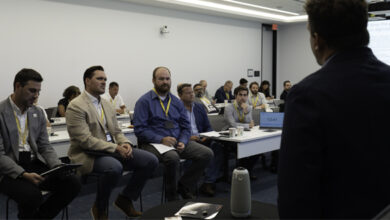Mud pump cavitation: Routine inspections, maintenance can prevent ‘silent killer’ from reducing rig efficiency, equipment reliability
With pumps being run at max horsepower at today’s well sites, best practices can help contractors to avoid premature damage, extend consumables life
By Adam Avey, Gardner Denver
Cavitation is an undesirable condition that reduces pump efficiency and leads to excessive wear and damage to pump components. Factors that can contribute to cavitation, such as fluid velocity and pressure, can sometimes be attributed to an inadequate mud system design and/or the diminishing performance of the mud pump’s feed system.
Other factors that contribute to cavitation include:
• Improper sizing of charge pump;
• Improper maintenance of charge pump impellers – worn impellers cause a reduction of fluid pressure;
• Dirty or clogged charge pump feed and discharge lines;
• Improper size of plumbing from charge pump to mud pump;
• Elevation changes and excessive elbows in plumbing from mud tank to mud pump; and
• Lack of or inadequate suction and discharge dampening.
Although cavitation is avoidable, without proper inspection of the feed system, it can accelerate the wear of fluid end parts. Over time, cavitation can also lead to expensive maintenance issues and a potentially catastrophic failure.
Mild vs severe cavitation

When a mud pump has entered full cavitation, rig crews and field service technicians will see the equipment shaking and hear the pump “knocking,” which typically sounds like marbles and stones being thrown around inside the equipment. However, the process of cavitation starts long before audible signs reveal themselves – hence the name “the silent killer.”
Mild cavitation begins to occur when the mud pump is starved for fluid. While the pump itself may not be making noise, damage is still being done to the internal components of the fluid end. In the early stages, cavitation can damage a pump’s module, piston and valve assembly.
The imperceptible but intense shock waves generated by cavitation travel directly from the fluid end to the pump’s power end, causing premature vibrational damage to the crosshead slides. The vibrations are then passed onto the shaft, bull gear and into the main bearings.
If not corrected, the vibrations caused by cavitation will work their way directly to critical power end components, which will result in the premature failure of the mud pump. A busted mud pump means expensive downtime and repair costs.
As illustrated in Figures 1 and 2, cavitation causes numerous pits to form on the module’s internal surface. Typically, cavitation pits create a stress concentration, which can reduce the module’s fatigue life.
Washouts are one of the leading causes of module failure and take place when the high-pressure fluid cuts through the module’s surface and damages a sealing surface. These unexpected failures are expensive and can lead to a minimum of eight hours of rig downtime for module replacement.
Preventing cavitation
Stopping cavitation before it starts is a matter of routine inspection and maintenance.
To stop cavitation before it starts, install and tune high-speed pressure sensors on the mud suction line set to sound an alarm if the pressure falls below 30 psi.
Accelerometers can also be used to detect slight changes in module performance and can be an effective early warning system for cavitation prevention.
Routine visual and auditory inspections of the pump may catch cavitation before it becomes catastrophic.
Although the pump may not be knocking loudly when cavitation first presents, regular inspections by a properly trained field technician may be able to detect moderate vibrations and slight knocking sounds.
By regularly checking the pump’s oil levels and maintaining the gear end, operators may be able to reduce or prevent damage to the pump.
Gardner Denver offers Pump University, a mobile classroom that travels to facilities and/or drilling rigs and trains rig crews on best practices for pumping equipment maintenance.
Program participants have found that, by improving their maintenance skills, they have extended the life of fluid end expendables on their sites. They have also reported decreases in both production and repair costs, as well as reductions in workplace hazards.
Results of cavitation
Once cavitation sets, there will be a reduced life span for expendables – as well as gradual wear on the modules and power end.
Severe cavitation will drastically decrease module life and will eventually lead to catastrophic pump failure. Along with downtime and repair costs, the failure of the drilling pump can also cause damage to the suction and discharge piping.
Cavitation in the field
Gardner Denver’s engineering team spent time on the contractor’s rigs, observing the pumps during operation and surveying the mud system’s design and configuration.
The engineering team discovered that the suction systems were undersized, feed lines were too small and there was no dampening on the suction side of the pump.
There were also issues with feed line maintenance – lines weren’t cleaned out on a regular basis, resulting in solids from the fluid forming a thick cake on the bottom of the pipe, which further reduced its diameter.
The team recommended increasing the diameter of the feed lines and routine cleanings to improve flow and reduce the risk of cavitation.
Following the implementation of these recommendations, the contractor saw significant performance improvements from the drilling pumps. Consumables life was extended significantly, and module washes were reduced by nearly 85%.
The improved performance reduced rig downtime and increased operational efficiency and customer satisfaction for the drilling contractor.
Impact on older drilling rigs
Although pump age does not affect its susceptibility to cavitation, the age of the rig can. An older rig’s mud systems may not be equipped for the way pumps are run today – at maximum horsepower.
Although daily inspections of mud systems’ feed lines and equipment are recommended for rigs of all ages, they are almost required for older models.
It may be impractical to flush system piping during drilling operations. However, strainer screens should be checked daily to remove any debris or other flow restrictions.
Additionally, pre-charge – also known as centrifugal – pumps should be inspected regularly to ensure adequate output flow and pressure.
Following these simple steps may help achieve maximum performance from pumping equipment and can reduce unplanned equipment outages. DC




